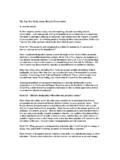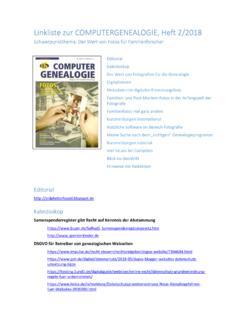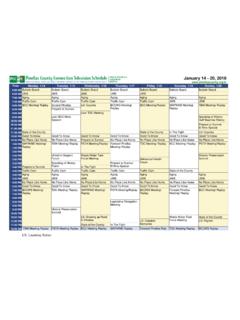Transcription of Management of Dead Bodies in Disaster Situations …
1 Management ofDead Bodiesin Disaster SituationsDisaster Manuals and Guidelines Series, N 5 Washington, , 2004 Area on Emergency Preparednessand Disaster ReliefDepartment forHealth Action in CrisisWorldHealthOrganization Also published in Spanish (2004 with the title:Manejo de cad veres en situaciones de desastre (ISBN 92 75 32529 4)PAHO Cataloguing in PublicationPan American Health OrganizationManagement of Dead Bodies in Disaster SituationsWashington, : PAHO, , -- ( Disaster Manuals and Guidelines on Disasters Series, N 5)ISBN 92 75 12529 5I. Title II. Series1. DEAD BODY2. NATURAL DISASTER3. Disaster EMERGENCIES4.)
2 Disaster EPIDEMIOLOGYLC HC553 Pan American Health Organization, 2004A publication of the Area on Emergency Preparedness and Disaster Relief of the Pan AmericanHealth Organization (PAHO) in collaboration with the Department Health Action in Crises ofthe World Health Organization (WHO).The views expressed, the recommendations made, and the terms employed in this publicationdo not necessarily reflect the current criteria or policies of PAHO/WHO or of its Pan American Health Organization welcomes requests for permission to reproduce ortranslate, in part or in full, this publication. Applications and inquiries should be addressed tothe Area on Emergency Preparedness and Disaster Relief, Pan American Health Organization,525 Twenty-third Street, , Washington, 20037, USA; fax: (202) 775-4578.
3 Publication has been made possible through the financial support of the Division ofHumanitarian Assistance, Peace and Security of the Canadian International DevelopmentAgency (IHA/CIDA), the Office for Foreign Disaster Assistance of the United States Agencyfor International Development (OFDA/USAID), the United Kingdom s Department forInternational Development (DFID), the Swedish International Development CooperationAgency (SIDA), and The European Commission s Humanitarian Aid department (ECHO).Cover and interior photos: PAHO/WHO iiiForeword ..ixPreface ..xiAcknowledgements ..xiiiChapter 1.
4 Preparedness for mass deathsIntroduction ..1 Coordinating institutions ..2 Duties ..3 Preparation of the plan ..4 Technical programs ..5 Body identification ..5 Epidemiologic surveillance and disease control ..5 Training ..6 Simulations ..7 Relations with the community ..8 Relations with the media ..8 Questions commonly asked after a Disaster ..9 Guidelines for the official spokesperson ..9 Proactive approach to media relations for the official spokesperson ..9 Conclusions ..10 Bibliography ..11 Chapter 2. Medicolegal work in major disastersIntroduction ..13 Organization of necessary personnel ..14 Organization and preparation of the team.
5 14 Formation of the group and the warning plan ..15 Risk and vulnerability studies ..15 Technical preparation of the team ..16 Cooperation agreements ..16 Exercises and simulations ..17 Material needs ..18 Transport ..19 ContentsMANAGEMENT OF DEAD Bodies IN Disaster SITUATIONSC ommunications ..20 Protective clothing and equipment ..21 Instruments and equipment ..23 Body preservation measures ..24 Temporary work cams or sites ..25 Water and food ..26 Medical care ..27 Participants ..27 Disaster professionals ..27 Other participants in Disaster response ..31 Operations coordination ..32 Search for information.
6 33 The place, the event, and the hazards ..33 Presumed victims ..34 Removal of dead Bodies ..36 Procedures at the Disaster site ..37 Transfer of human remains ..41 Holding and examination site ..41 Holding area ..41 Viewing area ..43 Examination area ..43 Methods for identifying human remains ..44 Identification using visual recognition ..44 Identification using anthropological studies ..45 Other methods of identification ..47 DNA identification ..47 Historic background ..47 DNA identification process ..49 Accepting cases, managing evidence, and maintainingchain of custody in DNA typing ..51 Final disposal of corpses.
7 58 Low temperatures ..59 Chemical processes ..59ivCONTENTSvEmbalming ..60 Burial ..65 Bibliography ..66 Special bibliography on DNA ..68 Chapter 3. Health considerations in cases of mass fatalities Introduction ..71 Myths ..72 Epidemiological risk of dead Bodies in areaswith endemic diseases ..73 Scientific basis of the absence of epidemiologicalrisk in non-endemic areas ..76 Animal corpses ..78 Conclusions ..81 Bibliography ..83 Chapter 4. Sociocultural aspectsIntroduction ..85 The funeral rite ..86 Changes in funeral rites through history ..88 Influence of culture, religion, and history on funeral ..89 The symbolic value of the corpse and burial.
8 95 Mourning and rituals in Disaster Situations ..97 Unresolved grief ..98 Arguments for the rapid disposal of corpses ..100 Disaster Management experiences ..101 Conclusions ..104 Bibliography ..106 Chapter 5. Psychological aspectsIntroduction ..109 Specific vulnerabilities ..110 Grief ..111 Management OF DEAD Bodies IN Disaster SITUATIONSThe process of unresolved grief ..113 Psychiatirc disorders among survivors ..116 Notification of disappearance or death, andvisual recognition of corpses ..119 Psychosocial care for survivors ..121 Psychosocial care for first response teams ..123 The importance of truthful, approriate, andtimely information.
9 125 Role of the authorities ..126 Conclusions ..126 Bibliography ..128 Chapter 6. Legal aspects Introduction ..129 General regulations on managing corpses ..129 Unidentified Bodies ..130 Missing persons ..131 Identification of numerous corpses ..134 Consequences of failure to identify corpses ..135 Provisions of national law ..135 Provisions of international law ..138 Conclusions ..146 Model law for Management of dead Bodies indisaster Situations ..148 Bibliography ..151 Chapter 7. Case studies The Peruvian experience in managing dead Bodies indisaster Situations : The Mesa Redonda fire, 2001 ..153 Introduction.
10 153 Actions of the Public Prosecutor s Office ..154 Actions of the Legal Medicine Institute of Peru ..155 Activities of the Public Ministry ..155viCONTENTSviiPublic Ministry staff involved ..158 Achievements ..159 Problems ..160 Repercussions of the event ..161 Conclusions and recommendations ..162 Management of dead Bodies following the avalanche of the Casitas volcano in Nicaragua: Chronicle of adisaster within a Disaster ..163 Summary ..163 Introduction ..163 Materials and methods ..164 Results ..164 The scene of the Disaster ..165 Institutional response ..166 Management of dead Bodies ..166 Discussion.












